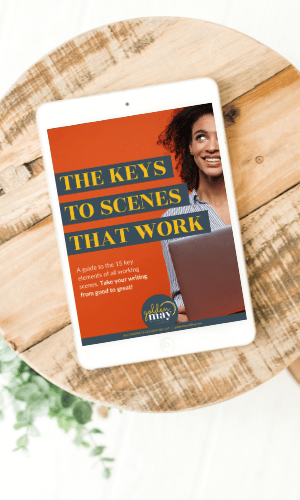“A story cannot be told about a protagonist who doesn’t want anything, who cannot make decisions, whose actions effect no change at any level.” —Robert McKee, Story
Imagine reading a story where the protagonist doesn’t want anything, doesn’t care about anything, and you have no idea what motivates them. That’s probably a book you’re going to put down pretty quickly. Why? Because you aren’t engaged in that story!
As we read, we want to cheer for the protagonist. We want to feel like we’re fighting alongside them as they’re taking down that evil corporation, as they’re breaking free from their traumatic past, or as they’re finding true love. They have to want something. Otherwise, why do we care?
To engage readers, your protagonist needs deep, passionate goals—goals they’re prepared to fight tooth and nail to get. Without goals, there’s no purpose to the character’s story and no reason for a reader to keep reading.
To create a compelling narrative that readers won’t want to put down, give your protagonist both External and Internal Goals that are strong enough to carry through the whole story, with dire stakes if your protagonist can’t achieve them. Then tie those goals directly to every scene and, ultimately, your character’s arc of change.
External vs Internal Goals
EXTERNAL GOAL: Your main character should have one all-consuming External Goal: the thing they are actively and passionately fighting for throughout the story. It’s the thing they consciously know they want, whether they’re aware of why they truly want it or not. This goal is the primary plot focus of the protagonist. It’s what they’re hoping to achieve or accomplish.
EXAMPLE: Let’s think about a common hero story: a prince has been kidnapped by a dragon and is being held captive in the highest room in the tallest tower of the dragon’s lair. A knight (the protagonist) has decided to fight the dragon and rescue the prince. In this story, the knight’s External Goal is to save the prince.
INTERNAL GOAL: The Internal Goal is the thing that they really, deeply want—it’s often subconscious, buried, or hidden. This is what is driving your character beneath the surface. The Internal Goal is what your character thinks their External Goal will give them. They may want the External Goal, but what’s truly driving them is their Internal Goal.
EXAMPLE: In our knight/dragon/prince story, the knight could have a strong desire to prove her strength. She may want to show the Queen, the people of her country, or maybe a family member, that she deserves to be taken seriously. So her Internal Goal is to prove she is strong so she will be respected.
To begin creating your character’s goals, answer these questions:
-
What is your main character fighting to accomplish throughout the story (their main plot focus)?
-
What does your main character actually want, on the inside, whether they know it or not (the thing that is truly driving them to desire their External Goal)?
Tie Your Goals to Your Character’s Arc
Your characters know what they think they want (their External Goal). You know what they really want (their Internal goal). Now you need to tie these two goals to your character’s internal arc of change.
An Internal Obstacle is the misbelief, lie, or flawed worldview that is causing dissonance between their External and Internal Goals. Your character’s Internal Obstacle is what’s leading them to think their External Goal will give them their Internal Goal.
EXAMPLE: Revisit our knight example above. The knight wants to save the prince and defeat the dragon (External Goal), but what she really wants is to prove her strength and be respected (Internal Goal). She only believes that saving the prince will earn her respect because she believes that “the only way to be respected is to be strong” (her Internal Obstacle). Her judgement is clouded by this false belief.
Build your character’s arc of change around how their Internal Obstacle influences them to act in pursuit of their goals. Your protagonist cannot actually accomplish their goals until they unlearn their Internal Obstacle belief and prove the story point. Only when they have truly changed can they get what they want—both internally and externally.
At the beginning of the story, your character sets out firmly believing their Internal Obstacle. They’ll make flawed choices as a result of their false belief, including their choice to pursue their External Goal. They’ll keep making these misled choices, until the negative consequences of their choices add up, forcing them to face their mistakes and therefore change. By the end of the story, your character has unlearned their Internal Obstacle belief, and learned your story point instead.
To begin tying your character’s goals to their Internal Obstacle, answer these questions:
- What Internal Obstacle belief leads my main character to think their External Goal will give them their Internal Goal?
- As my character pursues their External Goal, what false belief leads them to make flawed choices?
- What internal struggle is holding my protagonist back from achieving their goals?
Published Examples
How do Internal and External Goals work in published examples? Check out these breakdowns from An Ember in the Ashes by Sabaa Tahir and A Game of Thrones by George R. R. Martin. (Warning, spoilers!)
An Ember In the Ashes: Laia’s story opens with enemy soldiers killing her grandparents and capturing her brother. After leaving her brother to escape, Laia feels responsible. She wants to rescue him, but because of her Internal Obstacle (some people are inherently strong, others weak), she doesn’t believe herself capable, so she sets out to find rebels to help her.
- External Goal: Get the Resistance to save her brother from prison.
- Internal Goal: Make right her failure of leaving her brother behind.
A Game of Thrones: What Jon Snow really wants is to be free of the shame associated with his bastard name—yet, because of his Internal Obstacle (you gain honor through power), he sets out to achieve it the wrong way: seeking glory at the wall. But Jon finds out his goals are not compatible; he cannot pursue glory and honor at the same time. He must choose one over the other.
- External Goal: Prove himself a hero worthy of glory at the Wall.
- Internal Goal: Shed the shame of his bastard name by gaining honor.
Translate Story goals into Scene goals
To craft a tight and engaging narrative, you should make sure that your character is driven by their Internal and/or External Goals in every scene of the story. Yes, every scene! Readers will be engaged as long as your character is pursuing their overall goals. The second you shift to new, unrelated goals they’ll be jarred out of the story, wondering what’s going on and why it’s important. (Learn more about Scene Structure in this blog!)
EXAMPLE: Revisit our knight example above. The knight wants to save the prince and defeat the dragon (External Goal), but what she really wants is to prove her strength and be respected (Internal Goal).
Scene goals in the knight’s story might include: getting a horse so she can travel fast, finding someone who can lead her to the dragon’s tower, traveling to the tower, finding a way into the tower, etc. ——All of these goals are tied to her External Goal of saving the prince and defeating the dragon, and therefore also her Internal Goal, since the Internal is driving the External.
You might also see some character arc focused scene goals: agreeing to fight in a duel to prove her strength, trying to convince a mentor that her motives aren’t selfish, trying to get into the tower without her sidekick’s help, etc. ——All of these goals are tied to her Internal Goal of proving her strength and seeking respect. They’re tangential to the External Goal (and might even be delaying her pursuit of it!) but they’re led by the Internal Goal, so they’re still relevant.
The tightest and strongest scenes will show your character pursuing both their External and Internal Goals at the same time, so find ways to overlap if you can! (For the knight example, she could be arguing with her mentor while on her way to the next landmark in her journey to the tower.)
In Conclusion
Goals are how readers root for your main character! By giving your characters something to fight for, both internally and externally, you give your reader something to care about.








Leave A Comment